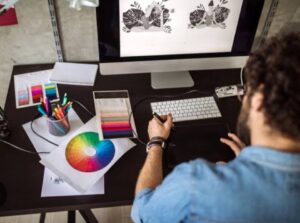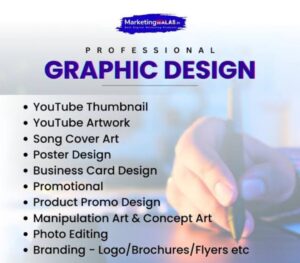🎨 What is Graphic Designing?
A Complete Guide for Beginners
What is Graphic Designing? In a world that scrolls faster than it reads, visuals speak louder than words. Whether it’s a brand logo, Instagram ad, product packaging, or website layout, all of these are the work of graphic design. But what exactly is graphic designing, and why does it matter so much in today’s digital age? In this blog, we’ll break it all down — from the definition of graphic design to the tools, types, and tips you need to get started.

💡 What is Graphic Designing?
At its core, graphic designing is the art of communicating ideas visually. It combines images, text, shapes, colors, and layout to deliver a specific message or create a visual experience. Graphic design isn’t just about “making things look pretty.” It’s about creating purposeful visual content that solves problems and influences how people think, feel, or act. Whether it’s an attention-grabbing poster, a clean app interface, or a minimalist logo — every design serves a function. It tells a story, builds identity, or drives action.
🚀 Why is Graphic Design Important?
You may not notice it, but graphic design touches every part of your life. From the moment you check your phone in the morning to reading a product label at night — you’re engaging with design.
Here’s why graphic design matters:
✅ First Impressions Count
Your brand only has seconds to make an impression. A well-designed logo or website can immediately build trust and grab attention.
✅ Builds Brand Identity
Consistent use of colors, fonts, and visuals helps create a strong, recognizable brand image. Think of brands like Nike or Apple — their visual identity is unmistakable.
✅ Improves Communication
Infographics, brochures, presentations — these visuals make information easier to digest and understand.
✅ Boosts Engagement
Eye-catching designs perform better on social media and in advertising, increasing clicks, likes, and shares.
> “Design is intelligence made visible.” – Alina Wheeler
🎨 Key Elements of Graphic Design
To create powerful visuals, designers work with a combination of essential elements:
Line – Used to guide the viewer’s eye or divide sections
Shape – Geometric or organic forms that make up the design structure
Color – Evokes emotions and highlights important elements
Typography – The style, size, and layout of text
Texture – Adds depth and realism
Space (White Space) – Gives elements room to breathe and increases clarity
When these elements are used thoughtfully, the result is a design that looks good and communicates effectively.
🌐 Types of Graphic Design
Graphic design is a diverse field with multiple areas of specialization. Here are some of the most common types:
1. Branding and Logo Design
Creating visual identities for companies — logos, color schemes, typography, and brand guidelines.
2. Web and App Design
Designing the layout and visuals for websites, mobile apps, and digital interfaces.
3. Social Media Graphics
Creating content for platforms like Instagram, Facebook, LinkedIn, and TikTok — posts, stories, banners, ads, etc.
4. Print Design
Traditional formats like brochures, flyers, business cards, posters, magazines, and billboards.
5. Packaging Design
Designing the containers and labels for physical products — combining branding with functionality.
6. Motion Graphics
Animated visuals for video, advertising, intros, YouTube content, and social media reels. Each type requires a slightly different skillset, but they all follow the same core design principles.
🛠️ Popular Tools Used by Graphic Designers
To bring their ideas to life, designers rely on powerful software tools. Some of the most commonly used include:
Adobe Photoshop – Ideal for image editing and photo manipulation
Adobe Illustrator – Best for creating logos, icons, and vector art
Canva – User-friendly, web-based tool for quick and easy designs
Figma – Excellent for UI/UX and collaborative design
CorelDRAW – A strong alternative for vector-based design
InDesign – Preferred for designing books, magazines, and layouts
Many tools have free versions or trials, making it easy for beginners to start experimenting.
👩🎨 How to Start Your Graphic Design Journey
You don’t need a degree to become a designer — all you need is passion, practice, and the right mindset.
Here’s how to get started:
1. Learn the Fundamentals
Understand basic design principles like alignment, contrast, color theory, and typography.
2. Choose the Right Tools
Start with beginner-friendly tools like Canva or Figma, then move on to Adobe Creative Suite as your skills grow.
3. Practice with Real Projects
Redesign an existing brand, create mock ads, or volunteer for non-profits — build a portfolio with real examples.
4. Take Online Courses
Websites like Coursera, Udemy, Skillshare, and YouTube offer great design tutorials — many of them free.
5. Stay Inspired
Follow design communities on Behance, Dribbble, or Pinterest to discover trends and get inspired.
🔥 Final Thoughts
Graphic designing is one of the most exciting and in-demand skills in today’s world. It’s not just a career — it’s a creative journey that blends art, communication, and technology.
Whether you’re a small business owner looking to build your brand, a marketer wanting better engagement, or a creative exploring new passions — learning graphic design is a smart investment.
📣 Ready to Dive into Graphic Design?
Looking to level up your visual presence or need help with professional designs?
👉 [Contact Us] for custom branding, marketing visuals, or website design that brings your ideas to life. Or explore more on our blog for tips, tutorials, and inspiration to start designing today!

